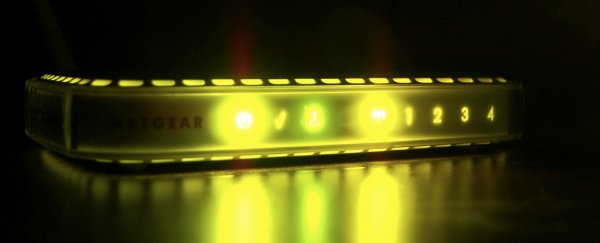Japanese researchers have announced that they've developed a new transmitter that can beam data at an incredible 100 gigabits per second (Gbps) - a connection speed that would let you download a Blu-ray film in a couple of seconds.
The transmitter works by sending data out at much higher frequencies than current routers, using the unchartered terahertz (THz) band to reach speeds close to those achieved by optical fibre.
Before you get too excited, the new technology and its alleged speeds haven't been peer-reviewed as yet. But if the reports are anything to go by, the transmitter could be the key to achieving Wi-Fi connections 10 times faster than is possible with existing technology.
To understand why the new transmitter is so fast, you need to know a little bit about how Wi-Fi works. Put very simply, our routers send out data as electromagnetic waves that are picked up by our computers and then converted back into information. Voila, you have an Internet connection!
Electromagnetic waves come in all different lengths, but our current transmitters send out waves in the gigahertz (GHz) band - around the 5 GHz range for standard routers, and up to 60 GHz for high-speed LAN connections.
The higher the frequency, the shorter the waves are, and, generally, the faster the connection. And the Japanese team have now reportedly managed to send out waves that are less than a millimetre in length - a frequency way up in the 275 to 305 GHz range.
Once you get up over that 300 mark, you're in the THz band, which is a benefit in itself, because that band is a whole lot less crowded. It's like being able to get from New York to London quicker simply by flying over the top of all the other aircraft traffic.
The researchers say they were able to achieve speeds of 100 Gbps across multiple channels using this THz band, but with further tweaking, they believe that could be pushed up into the terabit per second range.
"Today, we usually talk about wireless data-rates in megabits per second or gigabits per second. But I foresee we'll soon be talking about terabits per second," said lead researcher Minoru Fujishima from Hiroshima University. "That's what THz wireless technology offers."
"Such extreme speeds are currently confined in optical fibres," he added. "I want to bring fibre-optic speeds out into the air, and we have taken an important step toward that goal."
Of course, there are limitations to the THz band. Not only is it hard to develop transmitters that use these short waves, but, in general, these high-frequency signals have a shorter range and are less able to penetrate objects.
There's not a whole lot of detail on how this new transmitter will stack up when it comes to real-world applications - assumedly because the researchers are working with Panasonic, who would want to protect their new IP - but we do know it's been made using silicon, which means it could be easily integrated into today's technology.
The researchers also explained that the 100 Gbps speed was achieved using quadrature amplitude modulation - something that's commonly used now to enhance data rates within limited bandwidth.
Assuming all that checks out, the real hold up in getting these transmitters into our homes will be the fact that the THz band is still non-man's land for telecommunications. All wireless frequencies need to be allocated by the International Telecommunications Union Radiocommunication sector before they can be used commercially, and allocation won't be discussed for THz until 2019.
Hopefully that will give the researchers time to develop all the other parts they need to build a true THz wireless system.
"We plan to develop receiver circuits for the 300-GHz band as well as modulation and demodulation circuits that are suitable for ultrahigh-speed communications," explained Fujishima.
But the Japanese team isn't the only one pushing Internet speeds up - as we reported last year, light-based Internet known as Li-Fi has now been tested in the real world, and it's 100 times faster than regular Wi-FI.
Both technologies have their strengths and weaknesses, but one thing's for sure, our Internet isn't going to stay this slow for long. We can't wait.
